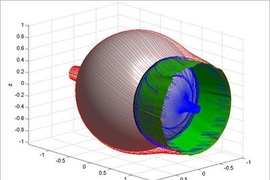As a car accelerates up and down a hill then slows to follow a hairpin turn, the airflow around it cannot keep up and detaches from the vehicle. This aerodynamic separation creates additional drag that slows the car and forces the engine to work harder. The same phenomenon affects airplanes, boats, submarines, and even your golf ball.
Now, in work that could lead to ways of controlling the effect with potential impacts on fuel efficiency and more, MIT scientists and colleagues have reported new mathematical and experimental work for predicting where that aerodynamic separation will occur.
The research solves "a century-old problem in the field of fluid mechanics," or the study of how fluids -- which for scientists include gases and liquids -- move, said George Haller, a visiting professor in the Department of Mechanical Engineering. Haller's group developed the new theory, while Thomas Peacock, the Atlantic Richfield Career Development Associate Professor in the same department, led the experimental effort.
Papers on the experiments and theory are being published in the Sept. 25 issue of the Journal of Fluid Mechanics and in the September issue of Physics of Fluids, respectively.
Fluid flows affect everything in our world, from blood flow to geophysical convection. As a result, engineers constantly seek ways of controlling separation in those flows to reduce losses and increase efficiency. One recent accomplishment: the sleek, full-body swimsuits used at the Beijing Olympics.
Controlling fluid flows lies at the heart of a wide range of scientific problems, including improving the performance of vehicles, Peacock said.
For example, picture air flowing around, over and past an object. "Instead of flowing smoothly past the object, the air tends to dramatically part from the surface, or separate," said Peacock. Like the wake behind a boat, the water doesn't automatically reconfigure into a single stream. Rather, the region is quite turbulent. "And that adversely affects the lift [or vertical forces] and drag [or horizontal forces] of the object."
In 1904, Ludwig Prandtl derived the exact mathematical conditions for flow separation to occur. But his work had two major restrictions: first, it applied only to steady flows, such as those around a car moving at a constant low speed. Second, it only applied to idealized two-dimensional flows.
"Most engineering systems, however, are unsteady. Conditions are constantly changing," Haller said. "For example, cars accelerate and decelerate, as do planes during maneuvers, takeoff and landing. Furthermore, fluids of technological interest really flow in our three-dimensional world," he added.
As a result, ever since 1904 there have been intense efforts to extend Prandtl's results to real-life problems, i.e., to unsteady three-dimensional flows.
A century later, Haller led a group that did just that. In 2004 Haller published his first paper in the Journal of Fluid Mechanics explaining the mathematics behind unsteady separation in two dimensions. This month, his team reports completing the theory by extending it to three dimensions. Haller's coauthors are Amit Surana, now at United Technologies; MIT student Oliver Grunberg; and Gustaaf Jacobs, now on the faculty at San Diego State University.
Equally important, this month Peacock and colleagues report important experimental work. Said Peacock, "while we fully trust George's new mathematical results, the engineering community is usually skeptical until they also see experimental results." Haller added, "while giving a beautiful validation of the 2D theory, Tom's work also gives strong experimental backing to our new 3D theory." Coauthors on the experimental work are Haller, Jacobs, Matthew Weldon, now at Penn State; and Moneer Helu, now at the University of California at Berkeley.
The research was initially supported by an internal source, the MIT Ferry Fund. Currently the work is supported by the Air Force Office of Scientific Research and the National Science Foundation.
The researchers said it's too soon to quantify the level of improvement in performance of cars and planes that might stem from the work, noting that more work must be done before it can be applied to commercial technologies. "This is the tip of the iceberg, but we've shown that this theory works," Peacock said.
A version of this article appeared in MIT Tech Talk on October 1, 2008 (download PDF).













